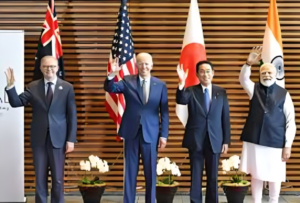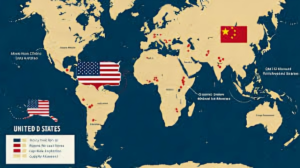Strengthening Supply Chains: How the US–Japan–India–Australia Mineral Pact Is Unnerving China
Introduction
In an era defined by rapid technological advancement and geopolitical rivalry, access to critical minerals has emerged as a cornerstone of strategic security and economic resilience. The recent four‑nation collaboration between the United States, Japan, India, and Australia—to diversify and secure supplies of rare earth elements, lithium, cobalt, and other essential resources—marks a significant shift in global resource governance. While proponents hail the pact as a necessary bulwark against supply chain disruptions, Beijing views it as a direct challenge to its near‑monopoly on key materials. This article explores the motivations behind the alliance, the real‑world implications for industry and policy, and why China’s leaders are growing increasingly uneasy.
Geopolitical Context and Strategic Imperatives
The post‑pandemic global economy has highlighted the fragility of concentrated supply chains. China currently controls over 80% of the refined rare earth market and plays a dominant role in processing lithium and cobalt—minerals vital for electric vehicles, wind turbines, and advanced electronics. For the United States, Japan, India, and Australia, the risk is twofold:
- Economic risk: Sudden export restrictions or price shocks could cripple manufacturing sectors reliant on high‑performance magnets, batteries, and semiconductors.
- Security risk: Military and aerospace applications depend on assured access to materials like neodymium and tantalum; any interruption poses a strategic vulnerability.
In response, the four partners have pledged to pool their mineral resources, coordinate investments in extraction and processing facilities, and share best practices for sustainable mining and recycling. By reducing dependence on a single supplier, they aim to build resilient, transparent, and environmentally responsible supply chains.
Real‑World Examples of Collaboration
- Joint Exploration Projects
- Australia’s vast lithium reserves are being mapped in cooperation with Japanese and Indian research institutes, combining geological expertise with advanced remote‑sensing technology.
- U.S. Geological Survey teams have partnered with Australian and Indian counterparts to identify underexplored cobalt deposits in remote regions, ensuring diversified sourcing.
- Processing and Refining Hubs
- A new processing facility in Western Australia, co‑financed by the U.S. Department of Energy and Indian public‑private consortia, aims to produce battery‑grade lithium hydroxide by 2027.
- Japan is supplying advanced hydrometallurgical equipment to Australia, reducing the environmental footprint of extraction and supporting local downstream industries.
- Recycling and Circular Economy Initiatives
- Pilot projects in India focus on urban mining—recovering rare earths from discarded electronics—backed by Japanese technological transfers.
- U.S. startups, with Australian venture capital funding, are scaling up battery recycling plants to reclaim cobalt and nickel, easing demand pressures on virgin mining.

China’s Growing Concerns
Beijing’s dominance is no accident; decades of investment in mining, refining, and processing have cemented its position. Yet the four‑nation pact threatens to erode this advantage by:
- Siphoning off demand: As allied countries shift orders to new suppliers, China’s state‑owned enterprises may face reduced volumes and lower revenues.
- Eroding market share: Long‑term supply contracts and shared R&D could give competitors a technological edge, diminishing the premium on China’s output.
- Setting environmental standards: Collaborative initiatives emphasize sustainable practices—stricter regulations and transparency could raise the bar for global mining operations, potentially sidelining less‑scrupulous players.
Internal Chinese media have begun to voice alarm. Commentators warn that the alliance aims not only to diversify supply but to encircle China economically, undermining its strategic leverage over high‑tech industries.
Implications for Industry and Policy
The mineral alliance carries far‑reaching consequences:
- Automotive and Electronics Manufacturers
Companies like Tesla, Toyota, and Samsung may benefit from more stable and potentially lower‑cost raw materials as competition increases among suppliers. - Defense Contractors
With a more reliable supply of specialty alloys and magnets, defense integrators in the U.S., Japan, and India can plan programs without the overhang of export restrictions. - Regulatory Frameworks
Governments are harmonizing environmental and labor standards, ensuring that new mining projects meet high social‑responsibility benchmarks, reducing the risk of backlash over land rights or pollution. - Investment Flows
Sovereign wealth funds and institutional investors are eyeing joint ventures in mining and processing as attractive long‑term bets, particularly in politically stable jurisdictions.
Challenges and Roadblocks
Despite the optimism, the pact faces hurdles:
- Capital Intensity: Developing mines and refineries requires billions in upfront investment, with long lead times before profitability.
- Technical Complexity: Extracting and refining many critical minerals safely and efficiently demands sophisticated technology that is still evolving.
- Local Opposition: Environmental groups and indigenous communities sometimes resist new mining proposals, citing ecological and cultural concerns.
- China’s Countermeasures: Beijing could retaliate with export quotas, strategic partnerships elsewhere, or price wars to deter buyers from shifting allegiance.
Success will hinge on sustained political will, private‑sector innovation, and meaningful engagement with local stakeholders.
Conclusion
The US–Japan–India–Australia mineral pact represents a paradigm shift in how leading democracies manage essential supply chains in an increasingly contested global environment. By pooling resources, sharing technology, and upholding stringent environmental and social standards, these nations aim to safeguard their economic security and technological leadership. For China, this emerging coalition is more than an economic challenge—it is a signal that the era of single‑source dominance may be giving way to diversified, resilient partnerships. As the dynamics of critical minerals evolve, industry and policymakers worldwide will be watching closely to see whether this alliance can deliver on its ambitious promise.
